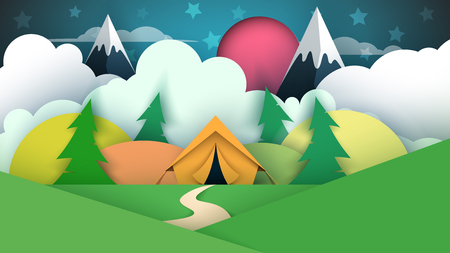1. Choosing a Safe Campsite
Picking the right spot to set up your tent is one of the most important steps to staying safe while camping. Whether youre heading out for a weekend getaway or your first overnight in the wild, knowing how to assess a campsite can make all the difference. Here’s what you need to consider:
Location Matters
Always choose a designated campsite when available. These sites are usually maintained by park services and offer safer conditions. If youre backcountry camping, look for flat ground that’s not too close to trails or cliff edges.
Terrain Assessment
Make sure the ground is level and free from rocks, roots, and sharp objects that could damage your tent or make sleeping uncomfortable. Avoid setting up at the bottom of hills or in dry riverbeds where water can collect quickly during rainstorms.
Proximity to Water
Being near a water source is convenient, but don’t camp too close. Aim for at least 200 feet away to reduce the risk of flooding and avoid disturbing local wildlife who rely on it.
| Distance from Water Source | Reason |
|---|---|
| 200+ feet | Avoids contamination and unexpected flooding |
| < 100 feet | Too close — may disturb wildlife and increase flood risk |
Wildlife Considerations
Stay alert for signs of animal activity such as tracks, droppings, or claw marks on trees. Don’t camp near berry patches, garbage bins, or any area with strong food smells — these attract bears and other animals.
Weather Impact
Check the forecast before heading out. Avoid camping under large trees if high winds are expected, and stay away from low-lying areas that could flood in heavy rain.
Pro Tip:
If you’re unsure about an area, ask park rangers or consult online maps and reviews. Other campers often leave helpful tips about safe spots and places to avoid.
2. Fire Safety Essentials
A cozy campfire is a big part of the camping experience, but it can also be dangerous if not handled properly. Whether youre roasting marshmallows or just enjoying the warmth, its important to build and maintain your fire safely and responsibly.
Understand Local Fire Rules
Before you strike a match, always check local fire regulations. Many national parks, forests, and campgrounds have specific rules based on weather conditions, fire risk levels, or seasonal restrictions. You can usually find this information on park websites or by asking a ranger.
Common Fire Regulations to Look For:
| Regulation | What It Means |
|---|---|
| Fire Bans | No campfires allowed due to high wildfire risk |
| Designated Fire Rings Only | You must use provided fire pits or rings for safety |
| Wood Restrictions | Only local firewood may be used to prevent spreading pests |
How to Build a Safe Campfire
Building a fire isnt just about stacking logs. Heres how to do it right:
- Pick the Right Spot: Use designated fire rings or clear a spot at least 15 feet away from tents, trees, and flammable materials.
- Create a Fire Ring: If one isn’t provided, surround your fire with rocks to keep it contained.
- Use the Right Materials: Start with tinder (like dry leaves), then kindling (small sticks), and finally larger logs.
- Keep It Small: A small, controlled fire is safer and easier to manage than a large one.
Preventing Wildfires
Your actions can make all the difference in preventing wildfires. Always keep an eye on your fire and never leave it unattended. Keep water, dirt, or a shovel nearby in case it starts to spread.
Quick Tips to Prevent Wildfires:
- Don’t burn during windy conditions
- Avoid using flammable liquids to start fires
- Keep your fire small and manageable
- Clear dry leaves and brush from around the fire area
How to Extinguish Your Campfire Safely
Packing up for the night? Make sure your fire is completely out before leaving. Here’s how:
- Drown the Fire: Pour water over the fire slowly until all embers are soaked.
- Stir the Ashes: Use a stick or shovel to mix ashes with soil and water.
- Drown Again: Repeat pouring water until no steam or hissing sounds remain.
- Feel for Heat: Carefully hover your hand above the ashes—if it’s still warm, it’s not safe yet.
A responsible camper always treats fire with respect. By following these simple steps, you’ll help protect nature—and yourself—for many adventures to come.

3. Wildlife Awareness and Encounters
One of the most exciting parts of camping in the U.S. is getting close to nature—but that also means sharing space with wildlife. While most wild animals prefer to stay away from humans, its important to take steps to avoid unwanted encounters that could be dangerous for both you and the animals.
Understanding Local Wildlife
Before heading out, research the types of wildlife that are common in your camping area. National parks and campgrounds often provide information on local species, including bears, raccoons, snakes, and even smaller critters like squirrels or chipmunks. Knowing what to expect helps you prepare appropriately.
Best Practices for Avoiding Wildlife Encounters
Follow these tips to minimize the chances of running into wildlife while camping:
| Do | Dont |
|---|---|
| Make noise while hiking to avoid surprising animals | Approach or try to feed wild animals |
| Keep a safe distance and observe with binoculars | Leave food scraps or trash behind |
| Use a flashlight at night to check surroundings | Sleep with food or scented items in your tent |
Proper Food Storage Techniques
Food smells can attract all kinds of animals—from bears to ants. Proper storage is key to keeping your campsite safe and clean.
Tips for Storing Food Safely:
- Use bear-proof containers: In areas where bears are common, use bear canisters or lockers provided by the campground.
- Hang food when necessary: If youre backpacking in remote areas, hang your food at least 10 feet off the ground and 4 feet away from tree trunks.
- Avoid scented items in tents: Keep toothpaste, deodorant, and snacks stored with your food—never inside your sleeping area.
- Clean up immediately after meals: Wash dishes and store leftovers right away to avoid attracting animals.
Respecting Nature and Wildlife Laws
The best way to stay safe is by respecting the natural environment. Always follow Leave No Trace principles: pack out what you pack in, stick to marked trails, and never disturb wildlife intentionally. Many national parks have specific rules about interacting with animals—follow them closely not just for safety but also to preserve these amazing spaces for others.
Quick Reminder:
- If you see animal tracks or droppings near your site, alert others and secure all food immediately.
- If an animal approaches your site, remain calm, back away slowly, and never run—especially if it’s a bear or mountain lion.
By taking these simple precautions and staying informed, youll create a safer environment for yourself and protect the wildlife that makes camping such an incredible experience.
4. First Aid and Emergency Preparedness
Being prepared for medical emergencies is a key part of staying safe while camping. Whether youre hiking deep into the backcountry or setting up camp at a developed campground, accidents can happen. Knowing what to do—and having the right supplies—can make all the difference.
Must-Have Items in Your First Aid Kit
A well-stocked first aid kit is essential for every camper. You can buy a pre-made kit or build your own based on your needs. Here’s a quick list of must-have items:
| Item | Purpose |
|---|---|
| Adhesive bandages (various sizes) | Cover minor cuts and scrapes |
| Antiseptic wipes | Clean wounds and prevent infection |
| Gauze pads and medical tape | Dress larger wounds |
| Tweezers | Remove splinters or ticks |
| Hydrocortisone cream | Relieve itching from insect bites or rashes |
| Pain relievers (like ibuprofen or acetaminophen) | Reduce pain or fever |
| Emergency blanket | Prevent hypothermia |
| CPR face shield | Aid in safe resuscitation |
Basic Survival Tips for Emergencies
If you ever find yourself lost or in an emergency situation, stay calm and follow these simple survival principles:
- Shelter: Find or create shelter to protect yourself from the elements.
- Water: Locate a clean water source or use purification tablets/filters.
- Signal: Use a whistle, mirror, or brightly colored gear to signal for help.
- Stay put: If youre lost, its often safer to stay where you are so rescuers can find you.
Handling Common Outdoor Injuries
Cuts and Scrapes
Clean the wound with antiseptic wipes, apply antibiotic ointment if available, and cover with a sterile bandage. Keep it clean and dry.
Bites and Stings
If stung by a bee, remove the stinger with tweezers. Apply ice to reduce swelling and use hydrocortisone cream or antihistamines for itching.
Sprains and Strains
Use the R.I.C.E method: Rest, Ice, Compression, Elevation. Avoid walking on the injured limb until pain subsides.
Burns (from campfires or stoves)
Cool the burn under clean running water for at least 10 minutes. Cover it with a sterile dressing. Do not apply ointments unless directed by medical advice.
Stay Ready for the Unexpected
You never know when an emergency might strike, so always let someone know your itinerary before heading out. Carry a map, compass, or GPS device even if youre familiar with the area. And dont forget to check local weather conditions before your trip—weather can change quickly, especially in mountainous areas.
The more prepared you are, the safer and more enjoyable your camping experience will be.
5. Staying Connected and Informed
When youre out in the wild, staying connected and informed can make a huge difference in your safety. Whether youre heading out for a weekend trip or a longer backcountry adventure, its important to know how to stay updated, navigate without internet, and keep others in the loop about your plans.
Check Weather Updates Before and During Your Trip
Weather can change quickly, especially in mountainous or forested areas. Always check the forecast before heading out using reliable sources like the National Weather Service (weather.gov) or weather apps like AccuWeather or The Weather Channel. If possible, bring a portable weather radio to receive NOAA alerts while camping. Sudden storms, extreme temperatures, or wildfire warnings can affect your safety and travel plans.
Use Offline Maps and GPS
Cell service is often unreliable—or completely unavailable—in remote camping areas. Download offline maps before your trip using apps like Gaia GPS, AllTrails, or Google Maps (make sure to select “Offline maps” in settings). A traditional paper map and compass are also smart backups.
Offline Navigation Tools Comparison
| Tool | Pros | Cons |
|---|---|---|
| Gaia GPS | Detailed topographic maps; hiking trail overlays | Requires subscription for full features |
| AllTrails | User reviews; trail conditions; easy interface | Free version limited for offline use |
| Google Maps (Offline) | Familiar interface; road navigation | Lacks detailed hiking info; limited topography |
| Paper Map & Compass | No batteries required; always works | Requires practice and basic skills to use effectively |
Communicate Without Cell Service
If you’re camping off-grid, consider devices that let you stay in touch even without cell reception:
- Satellite Communicators: Devices like Garmin inReach or SPOT allow two-way messaging and SOS signals via satellite.
- Walkie-Talkies: Great for group communication within a few miles.
- Emergency Whistle: Simple but effective tool to signal for help if needed.
Tell Someone About Your Trip Plans
This step is easy to forget but super important. Let a trusted friend or family member know the details of your camping trip, including:
- Your destination and route
- The dates you plan to leave and return
- The names of people going with you (if any)
- Your expected check-in time after the trip ends
If something goes wrong and you don’t return on time, this information helps search-and-rescue teams find you faster.
Staying connected doesn’t always mean being online—it means being prepared with tools and information that help you stay safe no matter where you camp.


